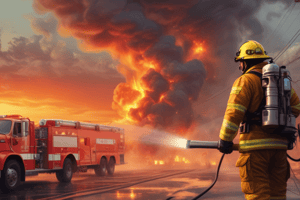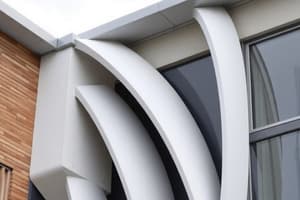Podcast
Questions and Answers
The phenomenon of smoke rising and spreading in buildings is referred to as ______.
The phenomenon of smoke rising and spreading in buildings is referred to as ______.
mushrooming
Inverse or reverse stack effect occurs in _____ high rise buildings in ___ weather
Inverse or reverse stack effect occurs in _____ high rise buildings in ___ weather
Air conditioned, hot
Effective ventilation at the top of the building's ventilation ______ is essential during high-rise fires.
Effective ventilation at the top of the building's ventilation ______ is essential during high-rise fires.
shafts
The ______ Grand Hotel fire in ___ ____ in 1980 highlighted the importance of top ventilation in saving lives during high-rise fires.
The ______ Grand Hotel fire in ___ ____ in 1980 highlighted the importance of top ventilation in saving lives during high-rise fires.
Smoke and thermal updrafts hinder evacuation during _____ rescue operations.
Smoke and thermal updrafts hinder evacuation during _____ rescue operations.
You should send __ FFs to the top to vent vertical openings with SCBA and ___ ____ tools.
You should send __ FFs to the top to vent vertical openings with SCBA and ___ ____ tools.
Opening hoistway doors during a fire may lead to issues such as zero visibility and risk of ______ down the shaft.
Opening hoistway doors during a fire may lead to issues such as zero visibility and risk of ______ down the shaft.
The hoistway opening is limited to a small size, typically - sq ft.
The hoistway opening is limited to a small size, typically - sq ft.
Smoke ______ may occur in sealed buildings when the smoke temperature is insufficient to rise to the top of the building.
Smoke ______ may occur in sealed buildings when the smoke temperature is insufficient to rise to the top of the building.
The ______ effect causes smoke to move down.
The ______ effect causes smoke to move down.
Venting the cooled smoke from the top of the building can be accomplished by ____ _____ fans blowing up ___ shafts and across smoke filled floors
Venting the cooled smoke from the top of the building can be accomplished by ____ _____ fans blowing up ___ shafts and across smoke filled floors
The ______ or reverse stack effect can occur in air-conditioned high-rise buildings during hot weather. In this case the temperature inside the building is ____ than the outside air. This dense air tends to sink to the bottom of the shafts and draws smoke and fire with it
The ______ or reverse stack effect can occur in air-conditioned high-rise buildings during hot weather. In this case the temperature inside the building is ____ than the outside air. This dense air tends to sink to the bottom of the shafts and draws smoke and fire with it
Set up fire lines (crowd control perimeters) at least _____ away in all directions
Set up fire lines (crowd control perimeters) at least _____ away in all directions
A major _____ commitment is needed to clear the buildings _____, surrounding streets and _____
A major _____ commitment is needed to clear the buildings _____, surrounding streets and _____
Once the lines are charged and operating, they (pump operators) should return to the apparatus cab and monitor engines ___ pressure, _____and so fourth
Once the lines are charged and operating, they (pump operators) should return to the apparatus cab and monitor engines ___ pressure, _____and so fourth
Cover lines with _____ to protect them
Cover lines with _____ to protect them
What is especially true of lower floor fires on cold days?
What is especially true of lower floor fires on cold days?
A slogan to keep in mind is
A slogan to keep in mind is
You can use ______ sensitive tape or ____ paper to apply to glass before breaking to pull it back into the building
You can use ______ sensitive tape or ____ paper to apply to glass before breaking to pull it back into the building
Some buildings have a thin layer of ____ in their windows to act as sunscreen
Some buildings have a thin layer of ____ in their windows to act as sunscreen
Gaining access to the ____ area is the ____ biggest problem in high rise fires
Gaining access to the ____ area is the ____ biggest problem in high rise fires
The fire dept must look at elevator use as a necessary ____; something to be avoided where possible and used when necessary
The fire dept must look at elevator use as a necessary ____; something to be avoided where possible and used when necessary
In buildings higher than ___ stories using the elevator becomes and absolute necessity
In buildings higher than ___ stories using the elevator becomes and absolute necessity
An elevator is also a requirement if you want to keep your reflex time to anything under - minutes.
An elevator is also a requirement if you want to keep your reflex time to anything under - minutes.
In a single story home reflex time may be as little as - minutes
In a single story home reflex time may be as little as - minutes
Reflex time is the total time elsapsed from the ____ of the alarm until a ____ is flowing on the fire
Reflex time is the total time elsapsed from the ____ of the alarm until a ____ is flowing on the fire
The ___ ___ is an elevator terminal for separate banks of elevators
The ___ ___ is an elevator terminal for separate banks of elevators
A ____ shaft elevator would serve 16-29 bypassing 1-15 to serve the upper floors
A ____ shaft elevator would serve 16-29 bypassing 1-15 to serve the upper floors
Sky lobbies are usually found on buildings more than ___ stories tall. They are a combination of express ____ shaft and ____ elevators with an elevator lobby on the ____ floors
Sky lobbies are usually found on buildings more than ___ stories tall. They are a combination of express ____ shaft and ____ elevators with an elevator lobby on the ____ floors
At a sky lobby it is necessary to get off and switch from the ____ to a ____ car for other floors
At a sky lobby it is necessary to get off and switch from the ____ to a ____ car for other floors
Two unusual phenomena that sometimes occur in high rises are the _______ of smoke below the top floors, and inverse (also called reverse) stack effect which causes smoke to move down
Two unusual phenomena that sometimes occur in high rises are the _______ of smoke below the top floors, and inverse (also called reverse) stack effect which causes smoke to move down
Flashcards
Stack effect
Stack effect
The natural movement of air within a building, caused by warm air rising.
Vertical Ventilation
Vertical Ventilation
The process of ventilating a building using the stack effect and building height.
Stack effect strength
Stack effect strength
Increases with building height, becoming noticeable above 60 feet.
Ventilation cause
Ventilation cause
Signup and view all the flashcards
Upper-floor window opening
Upper-floor window opening
Signup and view all the flashcards
High-Rise Fire Ventilation
High-Rise Fire Ventilation
Signup and view all the flashcards
Mushrooming
Mushrooming
Signup and view all the flashcards
Roof Ventilation Procedure
Roof Ventilation Procedure
Signup and view all the flashcards
Hoistway Considerations
Hoistway Considerations
Signup and view all the flashcards
Top Ventilation Shafts
Top Ventilation Shafts
Signup and view all the flashcards
Reverse Stack Effect
Reverse Stack Effect
Signup and view all the flashcards
Evacuation safety
Evacuation safety
Signup and view all the flashcards
Elevator Evacuation
Elevator Evacuation
Signup and view all the flashcards
Stairway Clearance
Stairway Clearance
Signup and view all the flashcards
Helicopter Evacuation Hazards
Helicopter Evacuation Hazards
Signup and view all the flashcards
High-Rise Building Fire Risk
High-Rise Building Fire Risk
Signup and view all the flashcards
Indoor vs. Outdoor Temperature
Indoor vs. Outdoor Temperature
Signup and view all the flashcards
Smoke Movement
Smoke Movement
Signup and view all the flashcards
Fire Location and Risk
Fire Location and Risk
Signup and view all the flashcards
Temperature Difference
Temperature Difference
Signup and view all the flashcards
Building Design Implications
Building Design Implications
Signup and view all the flashcards
Elevator Shaft Ventilation (High-rises)
Elevator Shaft Ventilation (High-rises)
Signup and view all the flashcards
Access Restriction (Fire)
Access Restriction (Fire)
Signup and view all the flashcards
Hoistway Safety Hazard
Hoistway Safety Hazard
Signup and view all the flashcards
Inadequate Ventilation (Elevator Shaft)
Inadequate Ventilation (Elevator Shaft)
Signup and view all the flashcards
Smoke Spread (Hoistway)
Smoke Spread (Hoistway)
Signup and view all the flashcards
Smoke Stratification
Smoke Stratification
Signup and view all the flashcards
Ventilation Strategy (High-rise Fire)
Ventilation Strategy (High-rise Fire)
Signup and view all the flashcards




